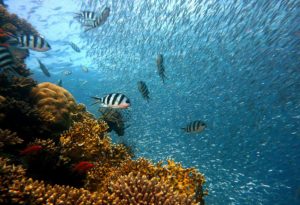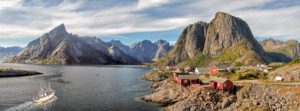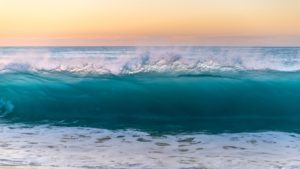The ocean start-up ecosystem might have too many start-up support organizations for the limited number of ocean start-ups.
Start-up incubators, accelerators, innovation hubs, and competitions represent a relatively new approach to fostering young businesses. Many of these support organizations offer entrepreneurs a blend of mentorship, funding, and networking opportunities that were not traditionally available in one package.
The concept of a support organization is an innovation itself, and the idea has spread widely. While there are generalist support organizations, there are also many supporting specific sectors like agriculture, pharmaceuticals, and ocean tech. As of this writing, there are 180 support organizations supporting ocean start-ups. You can view the data yourself here. I won’t claim this dataset is exhaustive, but it is fairly comprehensive. What does it tell us about the broader ocean tech ecosystem?
Start-up ecosystems
Just as a coral reef serves as the foundation for a coastal marine ecosystem, these support organizations are essential to the ocean start-up ecosystem. In a perfect world, the number of support organizations is in equilibrium with the number of ocean start-ups.
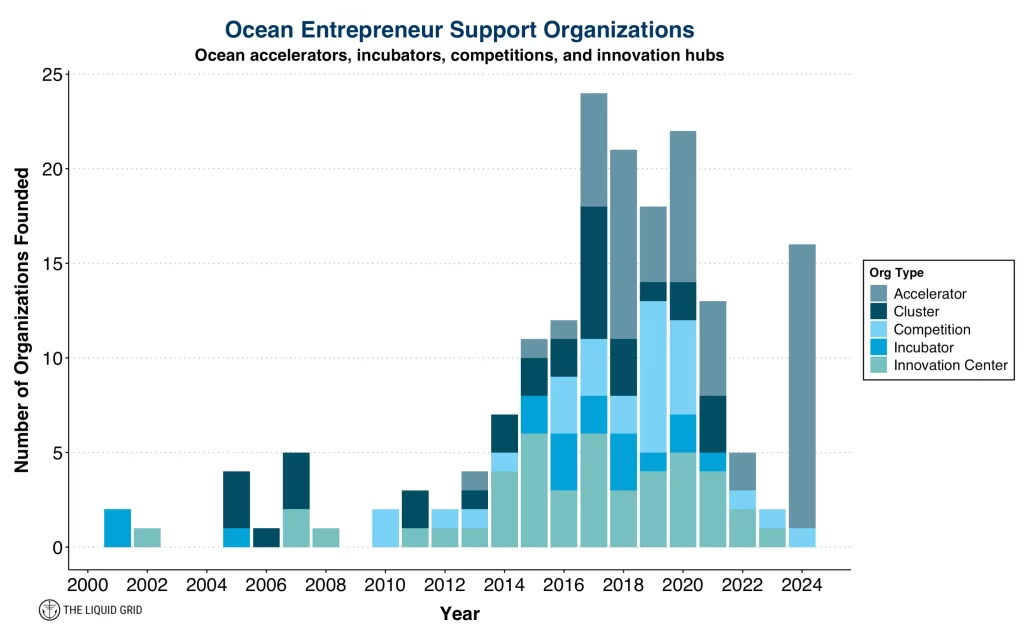
Tracking the creation of ocean tech support organizations helps us understand the number of ocean tech start-ups. We are not in a perfect world, but, logically speaking, if the number of support organizations is increasing then it would suggest that the number of ocean tech start-ups is also growing, and vice versa. As shown in the graph above, there was slow growth of ocean entrepreneur support organizations until 2013, followed by accelerated growth until 2017, a plateau, and then a rapid decline from 2020 through 2023.
This rapid growth is not specific to the ocean tech ecosystem. According to Brett Calhoun in a recent article for TechCrunch, there were over 8,000 accelerators worldwide as of 2020, more than half of which were started between 2014 and 2020. This aligns with the growth we see in the ocean ecosystem. Are we in the tail end of a boom and bust cycle?
Diffusion of innovation theory
This distribution should look familiar to any student of marketing theory; it’s very similar to the diffusion of innovations bell curve popularized by Everett Rogers in the 1960s. Rogers’ curve shows how ideas, technologies, or other innovations spread across a market over time. It’s been proven time and again across many products and services. Once a product or idea has sufficiently diffused across a market, that market is said to be saturated. Market saturation implies supply has outstripped demand or the potential customer base has been fully tapped.
Rogers Diffusion of Innovation Curve
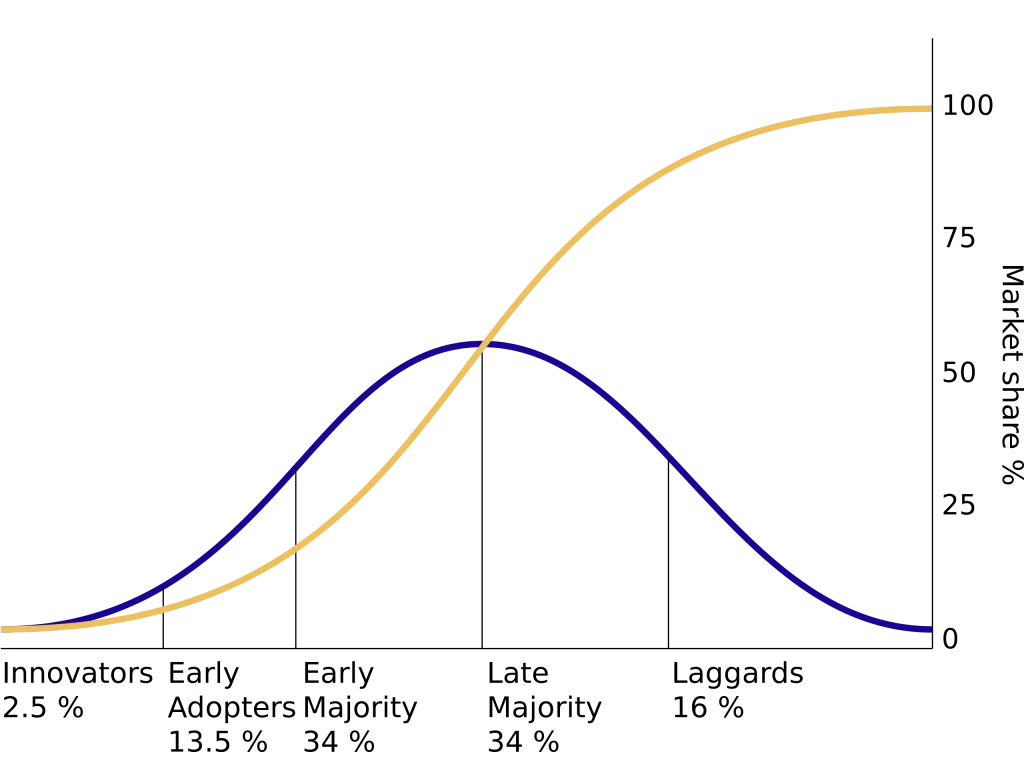
As noted previously, the concept of the ocean start-up support organization is an innovation unto itself. The market they serve are ocean start-ups needing mentorship. Ignoring 2024 for a moment, the diffusion of ocean start-up support organizations follows the typical bell-curve described by Rogers. Initially, a few innovators launched the first organizations to support ocean tech entrepreneurs. Over time, as success stories emerged, early adopters began to establish their own variants on this idea and build their own types of support organizations. This was followed by the early and late majority, and then the laggards.
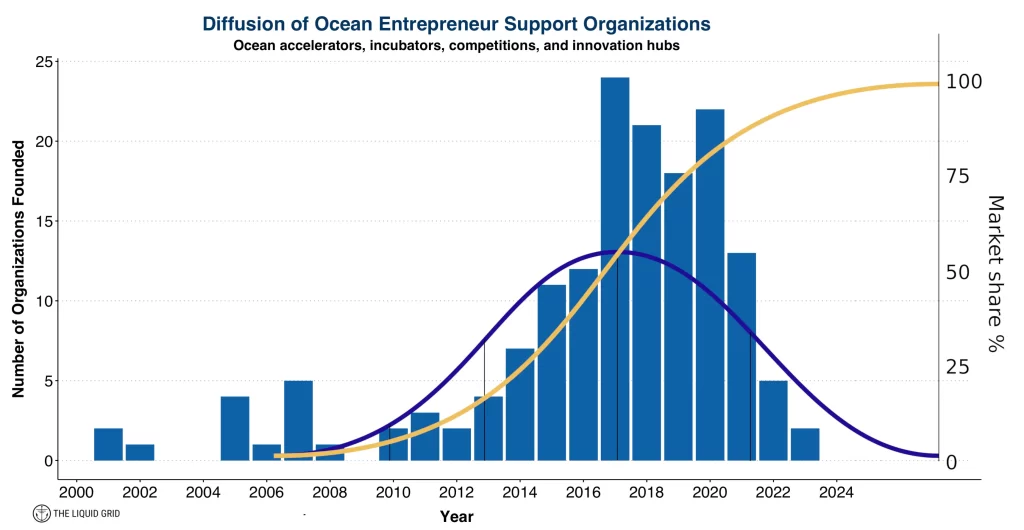
What about the spike in 2024? This is attributable almost entirely to a new funding program established within the United States by the National Oceanic and Atmospheric Administration (NOAA) providing grants to Ocean-based Climate Resilience Accelerators. NOAA’s Ocean Accelerator program made 16 awards to organizations across the United States in early 2024 for planning new programs. Some of the recipients were new to the ecosystem while others were existing players.
The saturated ocean start-up support market
It certainly seems the ocean start-up ecosystem has too many support organizations for the number of ocean start-ups that exist. NOAA’s infusion of grant funding for more support organizations in a saturated market might be best allocated to existing organizations instead of creating new ones.
However, if more start-ups are created, possibly through some of the innovation hubs that double as support organizations, this will increase demand for support organization services. Joshua Berger, founder of the maritime cluster organization Washington Maritime Blue comments,
“Despite the multitude of ocean ecosystem development initiatives, there remains a shortfall in innovative solutions reaching the market. While the entrepreneur support network is expansive and collaborative, there’s a need to create critical centers of excellence to enhance accessibility to both support and capital. Maritime Blue is in a unique position with a combination of deep industry partners, acceleration programs, and funding mechanisms.”
The research presented herein makes the assumption that the number of support organizations is a response variable to the number of start-ups. In other words, ocean support organizations are created within a region due to the number of ocean tech start-ups needing help. This is generally true. However, there are some ‘support’ organizations that are less about support and more about ideation and forming new ventures. Such organizations can help prime growth for the ecosystem.
Driving continued growth in ocean innovation
For the ecosystem to see continued growth, there should be more emphasis on supporting partnerships, market research, and idea generation that could lead to new start-ups and eventually full-fledged businesses. Many of the existing support organizations will need to pivot to this approach to see sustained growth. Since collaboration typically happens within a relatively small network and/or geography, this would emphasize a more localized or regional approach. This is the approach that Washington Maritime Blue is pursuing, jointly investing in ideation phases alongside start-up support.
Start-up growth is also influenced by available investment. The emergence of dedicated venture and angel funds like SWEN Blue Ocean Partners and Propeller Ventures specifically supporting ocean start-ups may also attract more young businesses, helping support organizations. However VCs may also erode the benefit of the supporting organization model since they increasingly provide similar services to an accelerator, as argued by Brett Calhoun in TechCrunch.
Unless there is a dramatic increase in the number of ocean start-ups needing support, it’s likely we’ll see a consolidation of support organizations. This is not a bad thing for the ecosystem. In fact, it’s natural for any market. While a saturated market is bad for suppliers, it offers potentially good deals for buyers. If you’re an ocean start-up, now is the best time to find support within the ocean start-up support ecosystem.

